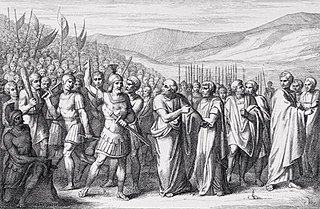Related Research Articles

The Battle of Lake Regillus was a legendary Roman victory over the Latin League shortly after the establishment of the Roman Republic and as part of a wider Latin War. The Latins were led by an elderly Lucius Tarquinius Superbus, the seventh and last King of Rome, who had been expelled in 509 BC, and his son-in-law, Octavius Mamilius, the dictator of Tusculum. The battle marked the final attempt of the Tarquins to reclaim their throne. According to legend, Castor and Pollux fought on the side of the Romans.
Titus Larcius was a Roman general and statesman during the early Republic, who served twice as consul and became the first Roman dictator.
Titus Aebutius Helva was a Roman senator and general from the early Republic, who held the consulship in 499 BC. He was magister equitum under Aulus Postumius Albus at the Battle of Lake Regillus. He was the father of Lucius Aebutius Helva, consul in 463 BC.

Aulus Postumius Albus Regillensis was an ancient Roman who, according to Livy, was Roman dictator in 498 or 496 BC, when he conquered the Latins in the great Battle of Lake Regillus and subsequently celebrated a triumph. Many of the coins of the Postumii Albi commemorate this victory of their ancestor, as in the one pictured. Roman folklore related that Castor and Pollux were seen fighting in this battle on the side of the Romans, whence the dictator afterwards promised a temple to Castor and Pollux in the Roman Forum.
Marcus Valerius Volusus was a Roman consul with Publius Postumius Tubertus in 505 BC.

The gens Postumia was a noble patrician family at ancient Rome. Throughout the history of the Republic, the Postumii frequently occupied the chief magistracies of the Roman state, beginning with Publius Postumius Tubertus, consul in 505 BC, the fifth year of the Republic. Although like much of the old Roman aristocracy, the Postumii faded for a time into obscurity under the Empire, individuals bearing the name of Postumius again filled a number of important offices from the second century AD to the end of the Western Empire.
Lars Herminius Aquilinus was consul in 448 BC with Titus Verginius Tricostus Caeliomontanus. Their year of office was relatively peaceful, as neither consul took sides in the conflict between the patricians and the plebeians.
The gens Verginia or Virginia was a prominent family at ancient Rome, which from an early period was divided into patrician and plebeian branches. The gens was of great antiquity, and frequently filled the highest honors of the state during the early years of the Republic. The first of the family who obtained the consulship was Opiter Verginius Tricostus in 502 BC, the seventh year of the Republic. The plebeian members of the family were also numbered amongst the early tribunes of the people.
Opiter Verginius Tricostus served as consul of the early Roman Republic in 502 BC, with Spurius Cassius Vecellinus. He was the first from the powerful Verginia family to obtain the consulship.
Aulus Sempronius Atratinus was a Roman Republican politician during the beginning of the 5th century BC. He served as Consul of Rome in 497 BC and again in 491 BC. He was of the patrician branch of his gens although the Sempronia gens also included certain plebeian families.
Proculus Verginius Tricostus Rutilus was a Roman statesman who served as Consul.
Aulus Verginius Tricostus Caeliomontanus was a Roman Republican politician and general of the gens Verginia. He served as a Roman consul in 494 BC together with Titus Veturius Geminus Cicurinus.
Titus Quinctius Capitolinus Barbatus was a Roman statesman and general who served as consul six times. Titus Quinctius was a member of the gens Quinctia, one of the oldest patrician families in Rome.

The first secessio plebis was a significant event in ancient Roman political and social history that occurred between 495 and 493 BC. It involved a dispute between the patrician ruling class and the plebeian underclass, and was one of a number of secessions by the plebs and part of a broader political conflict known as the conflict of the orders.
Titus Numicius Priscus was a Roman politician active in the fifth century BC and was consul in 469 BC.
Aulus Verginius Tricostus Caeliomontanus was a Roman politician active in the fifth century BC and was consul in 469 BC.
Publius Servilius Priscus was a Roman senator active in the fifth century BC and consul in 463 BC.
Lucius Lucretius Tricipitinus was a Roman senator in the fifth century BC, and was consul with Titus Veturius Geminus Cicurinus in 462 BC.
Marcus Valerius Maximus Lactuca was a Roman politician of the fifth century BC. Consul in 456 BC.
Titus Verginius Tricostus Caeliomontanus was consul of the Roman Republic in 448 BC with Lars Herminius Aquilinus. Little is known about his life.
References
- (in French) Tite-Live, Histoire romaine , Livre II, 21 sur le site de l'Université de Louvain ;
- Denys d'Halicarnasse, Antiquités romaines , Livre VI, 1-21 sur le site LacusCurtius.